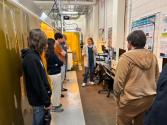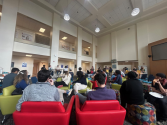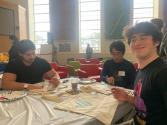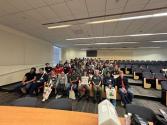SPS Zone Meeting
February 1, 2025
North Carolina State University, Raleigh, NC
Meeting host: By:Nora Hicks
SPS Chapter:
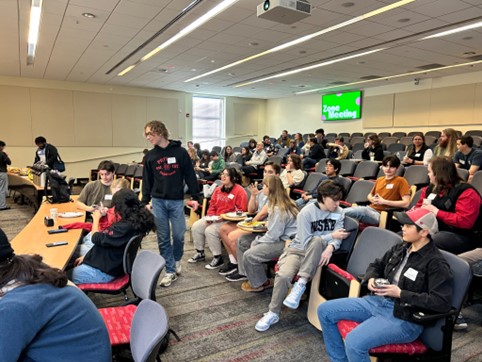
Society of Physics Students Zone Meeting Report
Introduction
The SPS Zone Meeting brought together physics students from across North and South Carolina for a day of learning, networking, and community-building. The event aimed to introduce students to scientific opportunities, foster professional and social connections, and create a lasting support system among peers. By participating, students were able to learn about new opportunities, share their research, and form friendships that will support their academic and professional journeys.
The meeting was held at North Carolina State University's Riddick Hall, which is home to the university's physics department. Riddick Hall provided an ideal setting, offering access to state-of-the-art labs and spacious rooms for interactive sessions.
Agenda Recap
- Check-in & Coffee (9:45 - 10:15 AM): Attendees arrived, signed in, and enjoyed coffee while meeting with students from other schools.
- Welcome and Introductions (10:15 - 10:30 AM): Nora Hicks, Anthony Kuchera, and Nico Salizar (NC State’s SPS President) welcomed everyone and went over the schedule for the day
- Ice Breakers (10:30 - 11:00 AM): Led by Nico, students participated in fun activities designed to encourage interaction between universities.
- SPS Announcements/PhysCon (11:00 - 11:30 AM): Nora provided updates on SPS awards, scholarships, and zone elections. Anthony discussed the upcoming PhysCon, fundraising, and encouraging attendees to participate.
- Lab Tours/Games (11:30 AM - 12:30 PM): Students toured three labs: Biophysics, Soft Matter Physics, and the Education and Research Laboratory (EaRL), which provides undergraduates with access to advanced technology. For those not participating in lab tours, physics Kahoot was played in the main room.
- Lunch & Graduate Panel (12:30 - 1:30 PM): Lunch was provided, followed by a graduate panel where students were able to ask questions about the application process and what it is like to be a graduate student in physics.
- Tote Bag Painting (1:30 - 2:30 PM): Students were able to socialize while they painted tote bags.
- Liquid Nitrogen Ice Cream (2:30 - 3:00 PM): Students helped prepare liquid nitrogen ice cream, offering a fun, hands-on demonstration that combined science with a sweet treat.
- Poster Presentation (3:00 - 3:30 PM): Students presented their research posters, gaining valuable practice in scientific communication.
- Closing Remarks (3:30 - 3:45 PM): Nico wrapped up the day's events, thanked participants, and then took a group photo.
Chapters and Attendance
The event saw a total of 51 attendees from the following institutions:
- North Carolina State University: 22 attendees
- East Carolina University: 3 attendees
- High Point University: 3 attendees
- Francis Marion University: 10 attendees
- Appalachian State University: 3 attendees
- Davidson College: 5 attendees
- University of South Carolina: 3 attendees
- Duke University: 1 attendee
- North Carolina Agricultural & Technical State University: 1 attendee
Recommendations for Future Zone Meeting Planning
1. Pre-Event Communication: Ensure all attendees sign up for lab tours in advance. Provide reminders and clarify the importance of pre-registration to avoid last-minute adjustments.
2. Flexible Scheduling: Build buffer time into the schedule to accommodate unexpected changes or delays, especially for popular activities like lab tours.
3. Activity Variety: Maintain a balance of academic, hands-on, and social activities. Tote bag painting was a major success and similar activities should be included in future events.
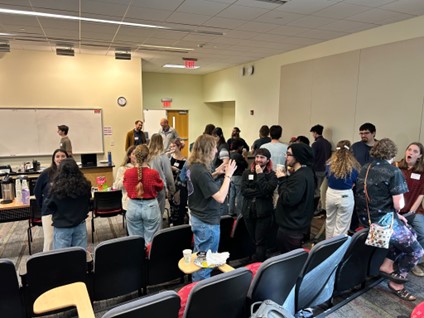
SPS Zone Meeting Narrative
On Saturday February 1st at NC State’s Riddick Hall, physics students from Fifty-one attendees from nine universities across North and South Carolina gathered for a day filled with scientific activities and community building. The day began at 9:00 AM, where NC State volunteers arrived early to ensure everything ran smoothly. They set up signs around the building, manned check-in tables at main entrances, arranged food, and prepared the presentation space. Around 9:45 attendees started to arrive and were greeted with bagels, cream cheese, yogurt, fruit, and an assortment of gluten-free and vegan snacks. Coffee, with a variety of creamers, added to the welcoming atmosphere as students mingled and chatted before the activities began for the day.
Welcome remarks from Nora, Anthony, and SPS President Nico officially kicked off the event at 10:15. Nico then led ice breakers that encouraged students to rotate partners every three minutes, helping them meet peers from different schools. The room buzzed with conversation as students discovered shared interests and exchanged contact information.
After the ice breakers, Nora and Anthony shared SPS announcements and details about PhysCon, generating interest among attendees unfamiliar with the national event. A brief break led into the lab tours, a much-anticipated part of the day. While only about 20 students had RSVP’d, many others joined spontaneously. Despite the last-minute adjustments, everyone was accommodated.
The lab tours were a highlight. Students visited the Bio Physics lab, Soft Matter Physics lab, and the Education and Research Laboratory (EaRL). Faculty and student guides stayed afterward to answer questions and discuss their research, motivating many undergraduates to consider research opportunities. The Soft Matter physics lab tour which was led by an undergraduate was the most popular tour. Her tour featured equipment used to study gradual physics, which just so happened to be lots and lots of colorful lights. Each room in the lab glowed a different color for each type of experiment and was very eye-catching.
Lunch followed in the Hearth—a spacious, well-lit area decorated with physics demos and art. Pizza, veggie trays, and gluten-free vegan options catered to everyone. During lunch, a panel of four graduate students shared their experiences in physics and grad school. The panel included a first-year student, a second-year student, one nearing the end of their PhD, and another midway through. The panel featured women and gender minorities, a mix of academic and industry goals,and both traditional and non traditional students. The diversity of the panel helped include and connect with all students in the audience. The panel offered valuable insights for students at all stages of their academic journeys. They discussed topics like selecting a PI, handling grad school challenges, and exploring non-traditional PhD paths. Many attendees found this session helpful, with several staying afterward to ask further questions.
Next, tote bag painting was held indoors due to rain. The Hearth became a creative space, with tables covered in tarps and a variety of stencils available. Students moved between tables, decorating personalized tote bags while chatting and listening to music. The activity was so popular that many wished it had lasted longer, offering a fun, artistic break from the day’s scientific focus.
The day continued with liquid nitrogen ice cream. Students were intrigued by the smoke from the liquid nitrogen and many students eagerly participated in making the ice cream. There was a variety of flavoring and topping including freeze dried strawberries, sprinkles, and chocolate, mocha, caramel and white chocalte syrup that students could put on either regular or dairy free ice cream. Following this student enjoyed their icecream as they watched their peers give poster talks.
Four students showcased their research, providing a glimpse into the diverse topics their peers were exploring:
1. Ian Simpson and Ryan Johnson presented "Studying the Total Solar Eclipse on 8 April 2024," featuring data on temperature, pressure, UV light, and audio recordings of wildlife.
2. Demi Butler presented "Advanced High-Resolution Imaging and Spectroscopy of NGC 2770, Messier 5, and the Orion Nebula," using imaging techniques from the Perkins Telescope Observatory.
3. Evan McNees presented "A Dynamical Model for the Decretion Disk in X-Persei," focusing on the hydrodynamical modeling of a Be X-ray binary star system.
The poster session was educational and engaging, giving presenters valuable practice and attendees a glimpse of the research opportunities available in physics.
As the day concluded, Nico delivered closing remarks, and group photos were taken to commemorate the event. Despite the full schedule, the energy and enthusiasm remained high. Attendees left with new friends, valuable knowledge, and a stronger connection to the physics community.
The SPS Zone Meeting was a great success, thanks to the hard work of volunteers, thoughtfully planned activities, and the active participation of students and faculty. It was a day of learning, connection, and professional development—an excellent example of SPS's commitment to academic and professional growth.


